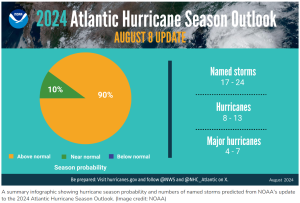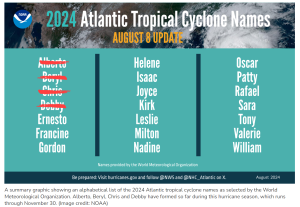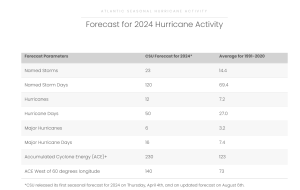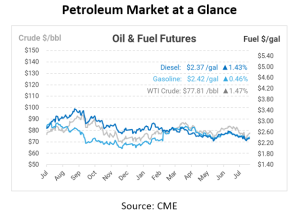
NOAA Reaffirms Expectation of ‘Highly Active’ 2024 Atlantic Hurricane Season
The National Oceanic and Atmospheric Administration (NOAA) has reaffirmed its prediction for a “highly active” Atlantic hurricane season in 2024, citing near-record sea surface temperatures and potential La Niña conditions as key drivers.
In its mid-season update, NOAA emphasized that both atmospheric and oceanic conditions continue to support its initial May forecast, which called for an above-normal hurricane season. The agency now estimates a 90% probability of above-average hurricane activity, leaving just a 10% chance for near-normal activity and virtually no chance of a below-normal season.

NOAA’s latest predictions include a total of 17-24 named storms with winds of 39 mph or higher, slightly refining its earlier estimate of 17-25 named storms. Out of these, 8-13 storms are expected to escalate into hurricanes with winds of 74 mph or greater, and 4-7 of these could further intensify into major hurricanes with wind speeds exceeding 111 mph.
This forecast accounts for the four named storms that have already occurred this season, which include two tropical storms and two hurricanes. Typically, the Atlantic hurricane season sees 14 named storms, seven of which become hurricanes, and three of those reach major hurricane status.

NOAA attributes this anticipated surge in storm activity to warmer-than-average sea surface temperatures in the tropical Atlantic and Caribbean, reduced wind shear, weaker tropical Atlantic trade winds, and an enhanced monsoon season in West Africa. The possible development of La Niña conditions—characterized by below-average sea temperatures in the equatorial Pacific Ocean—could further decrease wind shear in the Atlantic, allowing storms to develop more freely and potentially become more severe.
The energy sector is particularly vigilant during hurricane season, as tropical cyclones have the potential to disrupt fuel supplies and damage critical infrastructure like oil refineries. High winds, storm surges, and heavy flooding can also diminish gasoline demand by impacting transportation and economic activity.
In line with NOAA’s outlook, Colorado State University’s Tropical Weather and Climate Research Center also continues to project an “extremely active” hurricane season. Their latest update predicts 23 named storms, with 12 expected to evolve into hurricanes. Of these, six are projected to strengthen into major hurricanes of Category 3 or higher.

While NOAA does not provide specific predictions for the likelihood of storms making landfall in the U.S., the CSU team estimates a 56% chance of a major hurricane striking the U.S. this year, compared to the historical average of 43% between 1880 and 2020. The East Coast, including peninsular Florida, faces a 30% chance of being hit by a major hurricane, while the Gulf Coast—from the Florida Panhandle to Brownsville, Texas—has a 38% risk, both significantly above their long-term averages.
The Atlantic hurricane season spans from June 1 to November 30, with the peak period for storm development occurring between mid-August and mid-October.
Ready to implement an Emergency Plan? Talk to the experts!
Mansfield Energy, North America’s leading fuel distributor, brings a wealth of expertise to the table in creating a robust emergency response program tailored to your company’s needs. With an extensive network servicing the US and Canada, Mansfield understands the critical importance of proactive measures in facing potential disruptions caused by hurricanes or other natural disasters.
Leveraging in-depth knowledge, Mansfield has developed a comprehensive Emergency Response Fuel Program that prescribes industry best practices. Mansfield’s program enables a multi-faceted approach, prioritizing essential services and collaborating closely with partners to ensure seamless fuel distribution during emergencies. Contact us today!

This article is part of Daily Market News & Insights
Tagged:
MARKET CONDITION REPORT - DISCLAIMER
The information contained herein is derived from sources believed to be reliable; however, this information is not guaranteed as to its accuracy or completeness. Furthermore, no responsibility is assumed for use of this material and no express or implied warranties or guarantees are made. This material and any view or comment expressed herein are provided for informational purposes only and should not be construed in any way as an inducement or recommendation to buy or sell products, commodity futures or options contracts.





